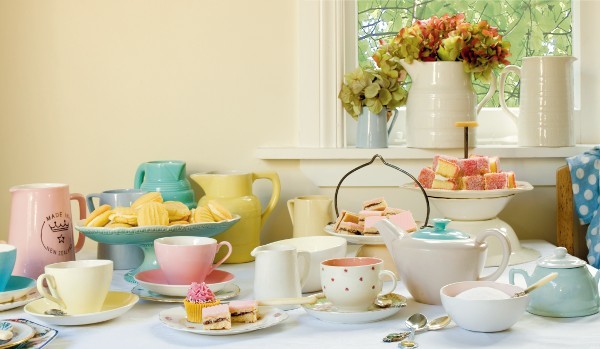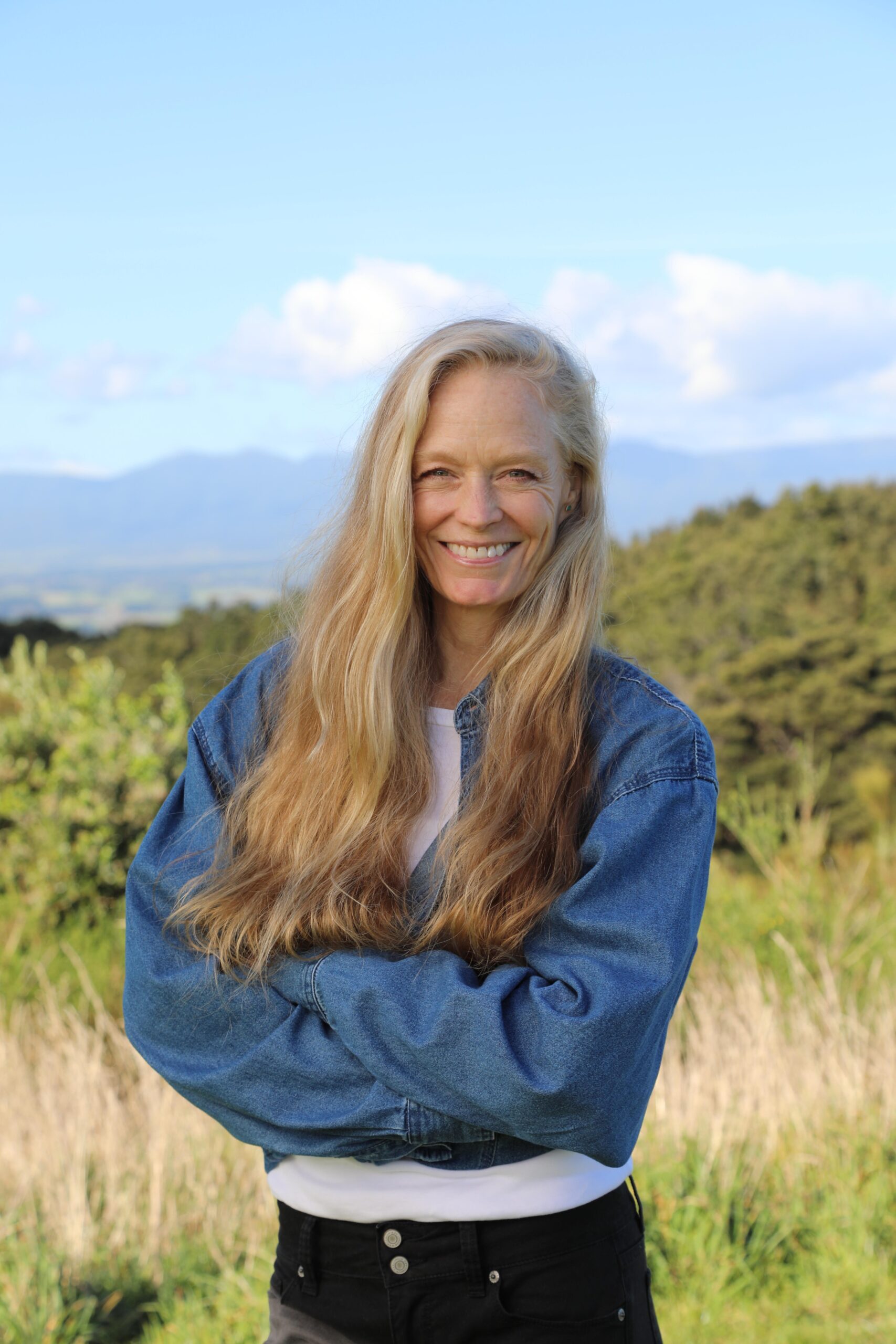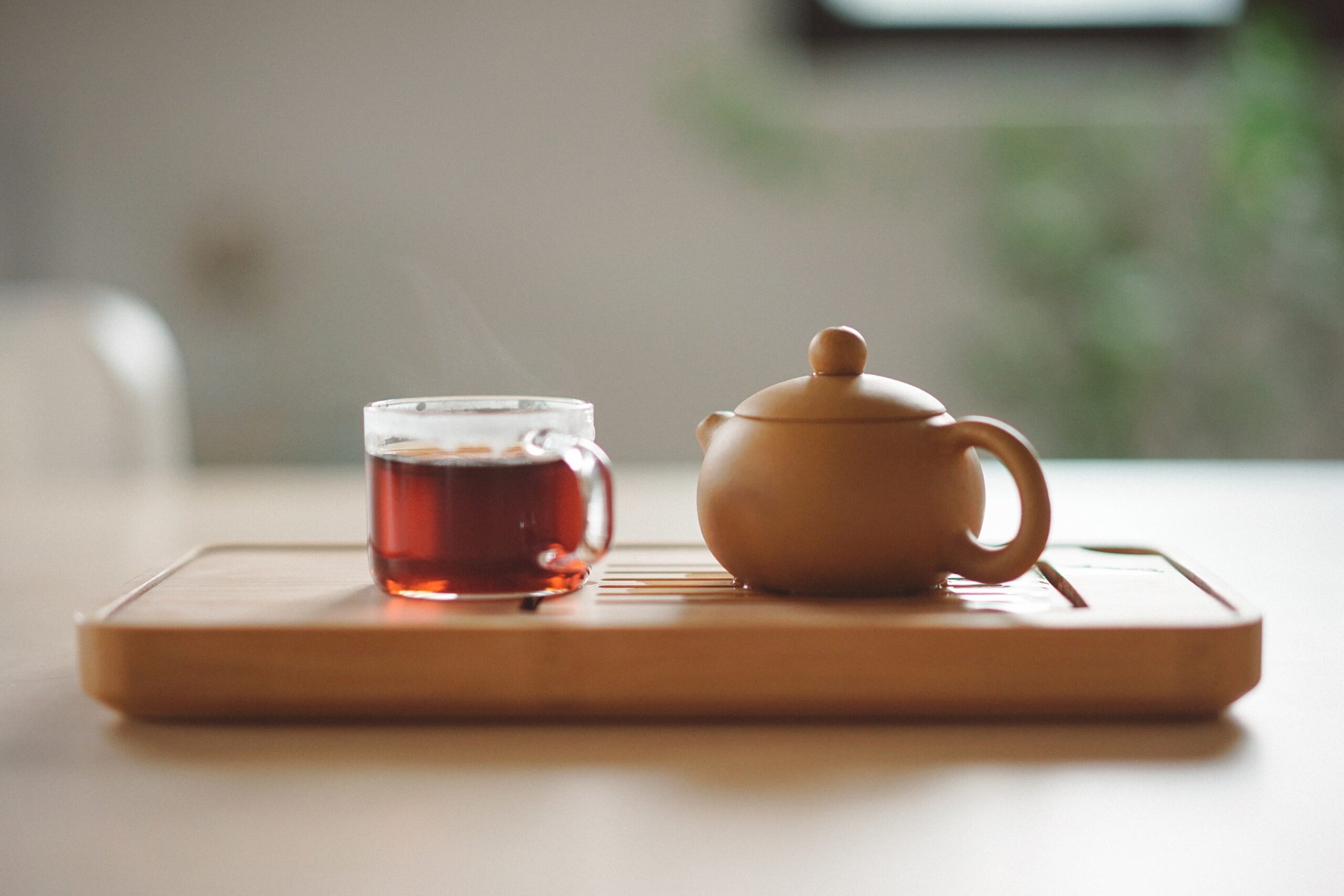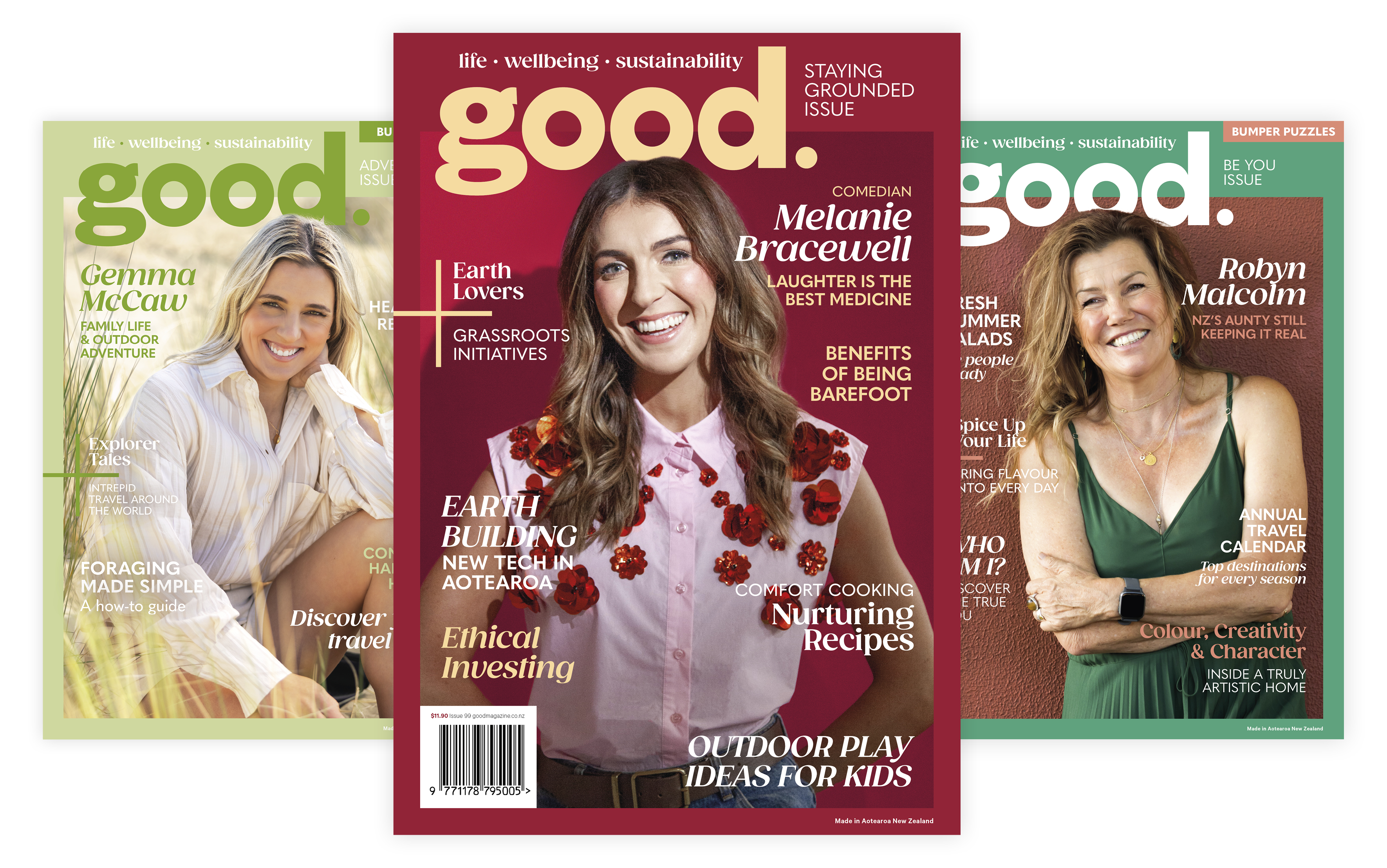And where to find them
Turn off the main highway to go hunting for beautiful things. Discover with Anna Hart how the vintage road trip makes the ultimate guilt-free shopping fix
Plus antiques expert Ross Millar shares his tips for getting the most from your treasure hunting
Photography Jane Ussher, Styling Sally Fullam
Melting moments by Anna Sephton; cupcake by Icing on the Cake; pink ‘Made in New Zealand’ jug by Studio Ceramics, from The Poi Room; medium yellow bowl and small pink bowl by Zekiah Heath, from The Poi Room; souvenir teaspoons from The Salvation Army, Gisborne; blue bowl from This ’n’ That, Marton; all others, stylist’s own.
We all aspire to own beautiful things, and most of us can’t help craving the occasional shopping fix. After all, nothing beats the thrill of returning from a day trip or short break with a fabulous new addition to your home or wardrobe. But how does a shopping splurge fit with trying to live a low-impact lifestyle or opting out of the rampant consumerism of our times? Can we indulge in a little retail therapy without the extra baggage of guilt?
Alluring as the idea of a shopping weekend in Sydney might be, for many of us the notion of such a dedicated shopping trip is starting to weigh a bit too heavily on the conscience. We can no longer ignore the carbon footprint of such a self-indulgent flight, the questionable origins of mass-produced items and the unpleasant afterthought that we’re contributing to the world’s overflowing landfills. Not to mention the severe pounding such a trip can give the credit cards.
Fortunately, here in New Zealand we’re blessed with a fantastic feel-good alternative to the standard shopping trip: the vintage tiki tour. As an itinerant op shopper and vintage fan, I’ve scoured flea markets in Poland, vintage boutiques in Paris, and Oxfam shops in London. After a year spent exploring New Zealand I’m now of the opinion that some of the world’s best vintage shopping is to be found here in the land of the long white cloud.
In this petite pair of remote islands, clothes, furniture and household items were traditionally made to last and fastidiously cared for so they could be passed on to the next generation. Before the 1980s, we weren’t flooded with cheap imported goods. What we lacked in new consumer products, we made up for with a good old Kiwi make-do-and-mend mentality.
What’s also become apparent to me during my time in this country is the lack of stigma attached to ageing or second-hand goods. Perhaps it’s because of New Zealand’s relatively young history, but items that have been in the family for yonks or that have a good story behind them are more likely to be cherished than not.

Above: cup and saucer set from Retro, Opotiki; vintage Lloyd Loom box covered with New Zealand wool rug; huia cushion made from vintage wool rug by Native Agent, from The Poi Room.
In Asia, second-hand stores are a rarity because new, mass-produced items are so cheap and readily available. In Eastern Europe, the austere economic climate of much of the last century meant that few fashionable clothes and household goods were produced during the 1950s, 60s and 70s, and today the concept of ‘vintage’ being remotely desirable has yet to take hold.
New Zealand, by contrast, has a venerable tradition of second-hand shops. This may have been born of necessity, but these days retro furniture, Kiwiana artwork and vintage fashion are the height of cool. Second-hand stores are increasingly being rebranded as antique, retro, collectables and vintage boutiques, and are multiplying in fashionable urban hubs.
Rich pickings are still to be had in the second-hand scene. But, as every antiques buff, vintage queen and art hunter knows, to snag a real find you need to venture further afield, away from the eagle eyes of Auckland’s fashionistas or Wellington’s hip art students. It’s the out of the way, tourist-free corners of New Zealand where you’ll find the 1950s Dior day dress, the collection of macramé owls, or that quaint handmade patchwork quilt – and still at bargain prices.
This winter, why not gather together a few girlfriends and set off on a guilt-free shopping tiki tour of your own? Chances are, you’ll come home with a slice of history and change to spare.
– Anna Hart
On the trail

Paeroa’s Main Street and Granville’s Antiques, below
Decide what you’re planning to collect and then just get out there, says antiques expert Ross Millar. Have fun – the worst mistake you can make is to not stop the car and enjoy looking around. Here are seven more tips to get started:
• Repeat visits are the key to getting the most from second-hand hunting. You’ll soon get an idea of which shops stock collectables that interest you. But don’t despair if there’s nothing you want in any one visit. Next week the stock could have all changed.
• Your best ally is the shop owner. Let owners know what you’re after and then they can call you if they get new stock that might appeal. Second-hand shop owners are small businesses and they know the best way for them to survive is to communicate with their customers.
• The rule is ‘first in, first served’ – but you do need to keep in mind the likelihood of finding something similar elsewhere. Is the piece relatively rare, or could there be a similar item available in the shop across town? Was the item originally commonplace and mass produced or was it expensive in its day and produced in limited quantities?
• Do a little background research. Collecting is much more fun when objects are imbued with the stories of people and places. Geoffrey Godden’s New Handbook of British Pottery and Porcelain Marks is an invaluable reference for marks and monograms. Marks of New Zealand Potters: A Comprehensive Directory 2007, by Margaret Bell, is also an essential source of information if you are planning to collect New Zealand studio pottery. Check out the NZ Potters Inc book list (www.nzpotters.com), plus there’s plenty of information to be had from enthusiast websites such as www. collectables.co.nz. The Crown Lynn Shape Guide can be searched online and is a useful source of information, as is Valerie Ringer Monk’s book, Crown Lynn: A New Zealand Icon, Penguin 2006.
• Kiwiana is big at the moment, the laidback craft and retro look reflecting our casual lifestyle. But don’t be afraid to step outside that sphere and choose a theme that can be totally yours. Kiwis are followers of fashion: 30 years ago we collected vintage Royal Doulton china as if it were the last thing on earth and prices climbed until even ordinary mass-produced items were fetching high prices. Then the market corrected itself and prices dropped.
• Faults can affect an item’s value. Chips and cracks on china and glass, and scratches on furniture, can cause an item to drop in value – sometimes considerably. This is an opportunity if you have restoration skills, but a poor fix-it job can also mean a loss of value. Factor an item’s condition into the price.
• Don’t become too obsessed with getting the absolute bargain. If you love what you’ve bought and you’re not intending to resell it for profit, then you have a bargain. If you resell it years later and it doesn’t make a profit, you need to factor in the years of use or pleasure you’ve gained – again, you may have a bargain. Sometimes you’ll pay a bit much, mostly you’ll have a win. The key is to enjoy the journey. On a hot day it’s the perfect excuse to stop the car in a little country town and take twenty minutes to ferret in junk and antique shops.
Code cracking
Start looking more closely at old plates and other ceramics and one of the first things you’ll notice is their mysterious – and often quite beautiful – marks and monograms. Learning to decipher these cryptic symbols is to catch a tantalising glimpse into an object’s past life.

Mix and match Crown Lynn pieces including Roydon South Pacific, Capri and Colourglaze ware.
Knowledge is power, so put in a bit of spadework to help you find the best buys. Start by looking for clues in the factory or the maker’s marks; your locally made ceramic could be anything from a piece of commercially produced Crown Lynn china to studio pottery produced by an award-winning potter such as Len Castle.
Crown Lynn is the ubiquitous china that was made in huge quantities before the Auckland factory was closed in 1989. This mass-produced tableware – at one time around 17 million pieces were being produced annually – is still in abundance and relatively cheap to collect. Often, the only indication that a piece is from the Crown Lynn factory is an incised shape or number.
Other Crown Lynn pieces are more sought after – and more valuable. Individual pieces from the renowned 1950s designer Frank Carpay, for instance, can fetch over a thousand dollars. Frank Carpay signed his pieces with a cipher, a hand print, and the Dutch word ‘werk’ (meaning work) or sometimes ‘handwerk’, indicating the individual process of decoration. Although Crown Lynn’s Specials Department produced some of the most collectable material, it’s often only marked with impressed or incised shapes or numbers.
By contrast, the manufacturer’s marks on English china often include codes for shapes, dates, designers, artists and assistants. For example, pieces from Doulton’s Lambeth factory include incised monograms of the artists who worked on pieces along with impressed alphabetical stamps of assistants, who were mostly young women.
–Ross Millar
Vintage treasure hunt
Anna Hart and Sally Fullam each take the low road and search the smallest towns to uncover the quirkiest collectables and fabulous op-shop finds

Watson’s, Carterton
Just a few kilometres off State Highway 1, the charming wee town of Waipu is the perfect lunch stop or overnight break on your way north. The pint-sized museum tells the story of the town’s original 940 Scottish settlers, forced off their farmland in the Scottish Highlands and into boats which took them first to Nova Scotia and finally to the sunnier climes of Bream Bay. An organic shop and cafe serves up healthy lunches to grateful travellers, and a liberal sprinkling of antique and collectables shops (plus the church op shop) make it worth the stop. The prettiest of the pack is Eye Spy, housed in the old fire station and selling vintage tooled leather satchels, 1970s Danish furniture and one-off pieces made by the bubbly owner, Jo. Throughout June, July and August, the Winter@Waipu festival sees a series of events designed to showcase the town’s Scottish heritage.
Not just an elegantly tree-lined watering hole for wealthy dairy farmers and leather-booted horsey folk, Cambridge is also a top spot for op shops. There are four in close proximity, offering a good selection of New Zealand woollen blankets, linen and sewing items. The Union Parish Op Shop on Victoria St has beautiful, hand-embroidered hankies, doilies and tablecloths going for a song, and the Hospice Waikato shop on Drake St has quality antiques priced accordingly, including a SylvaC vase in perfect condition for $20. The nearby Red Cross shop and Salvation Army store are more of a mixed bag but still worth a look.
Paeroa once had to erect a giant L&P bottle to persuade travellers to stop and take advantage of this fine photo opportunity. Today it’s the vast array of antique and vintage clothing shops which lure Aucklanders on their way to Tauranga and the Coromandel. Dip into the Coachman’s Cafe for a famous Coachman’s pie before picking up a purple ‘Antique & 2nd Hand Trail’ leaflet. With old-style lodgings like the Criterion Hotel and the Paeroa Hotel offering rooms from around $50 a night, it’s worth staying on. Take a wander through uncovered railway tunnels in the spectacular Karangahake Gorge, then share a platter at the Ohinemuri Estate Winery.
Caught Short, a second-hand shop just off State Highway 1 in Taihape, is a veritable treasure trove of large items, including furniture such as a 50s dining room table and oak chairs, as well as appliances, brica- brac, clothes, trinkets, good kids’ books (including some vintage school readers), puzzles and tools. “I picked up a heavy preserving pan, old Agee preserving jars, a fruit stone remover and some helpful advice on preserving from the two women who worked there,” says Sally.
It’s a little off the main highway but the ten-kilometre deviation to the pretty town of Marton is well worth it. This ‘n’ That on Wellington Road offers a selection of well-priced collectables, including cup and saucer sets, an assortment of records, old school mobiles, furniture, wooden ware, glassware and bakeware. Look out for old handmade muffin trays that can be used to display found objects, buttons and beads.
Pass through Greytown on a Saturday morning and you’re likely to find the cafes and fashion boutiques busy with locals and Wellington day trippers, and a queue out the door of the French bakery. Country Trader Antiques and Interiors on Main St is well worth a stop, offering a tasteful mix of old and new French country-inspired homeware, linen, tableware, glassware and furniture. There are also some lovely locally crafted pieces of recycled and reappropriated 50s industrial furniture – from kitchen work stations to bedside tables.
Brass Knob Antiques at 67 Main St, a little shop tucked down a driveway behind the butcher’s, also harbours some treasures.
Watson’s and The Old Mill on Carterton’s High St is definitely a shop to check out, with fabulous items that include 1950s formica tables, cast-iron bedheads, china, enamelware, kitchenalia, farming implements, bottles, old tins, metal containers and ceramics. Next door to Watson’s is a half-empty arcade with the store Verity tucked at the end. It is stuffed full of vintage and retro clothes and coats, linen and fabric, books, costume jewellery, tea sets, collectable miniatures and old-rose china.
The East Cape beaches are beautiful and remote, and the town of Gisborne has a laid-back, relaxed vibe. We stayed in a delightful little cottage by the sea at Tatapouri Bay, 10 kilometres to the north. An evening lying on comfy beanbags and eating pizzas at the historic Dome Cinema is also to be recommended. For more on an East Cape road trip, pick up the excellent official visitor guide ‘Out East’, which includes maps, routes, freedom camping information, plus a comprehensive list of things to do and where to eat and sleep.
The A1 Mart on Gladstone Road is a fantastic second-hand shop with a good range of collectables, including a selection of Crown Lynn Colour Glaze, ceramics and Depression Glass, plus Kiwiana, 1950s kitchenalia, enamelware, tools, household items, costume jewellery and coins.
Bird of Prey is another fab little shop on the main street. Amanda Laidlaw- May is one of the owners, and her background as an interior designer is apparent in the store’s beautiful mix of new and well-chosen vintage pieces. The shop also sells locally made gifts, homeware, ceramics, artwork, jewellery and fashion. The nearby Salvation Army shop is big and busy with a constant flow of locals through the door and offers vintage blankets, 60s dress patterns and souvenir teaspoons.
Retro Vintage & Antiques (on the corner of King St and Church St) in the sleepy Bay of Plenty town of Opotiki has a fantastic collection of Crown Lynn, a wall of cup and saucer sets, kitchenalia, furniture and enamelware. “I’d been searching for a nice old colander for a while, so I was very excited when I spied one in a dusty stack,” says Sally.
The deep south op shops of Gore and nearby Invercargill are legendary among Auckland’s fashionistas, many of whom travel down for the annual Hokonui Fashion Design Awards. A full-length 1970s sheepskin jacket for $15, a complete set of Crown Lynn crockery and a pair of fabulous vintage clogs were all on offer on a recent visit.
The Eastern Southland Gallery (‘Goreggenheim’, as the locals call it) houses an impressive collection of New Zealand art, and the quirky Hokonui Moonshine Museum tells the fascinating history of illicit whisky making in the area. If there’s not enough local excitement, a visit to the Old Mandeville Airfield for a flight in a 1930s Tiger Moth will inject some adrenaline into your stay.

“I bought these two plywood chairs seven years ago on Trade Me for $200 each, and re-upholstered them with an Osborne & Little fabric,” says Sally. “During a visit to London’s V&A gallery, I was delighted to discover an exact set of these chairs in an exhibition of leading 20th century British designers. The chairs had been designed by G. A. Jenkins for The Packet Furniture Co. in the early 1950s. Learning a little more about their provenance and how they fit with classic UK design trends adds to my enjoyment of them as well as increasing their potential re-sale value.”
For more, go to good.net.nz/collectables or check out www.myantiqueshops.co.nz







